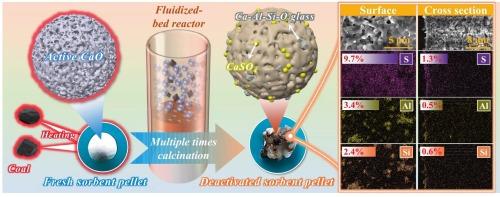流化状态下煤助烧cao基吸附剂的失活特性
IF 7.5
1区 工程技术
Q2 ENERGY & FUELS
引用次数: 0
摘要
煤燃烧是钙环(CaL)体系中煤基CO2吸附剂再生的典型热源。然而,煤燃烧对流化床煅烧炉内cao基吸附剂的影响机制以及这种影响的程度仍不清楚。本文以煤为热源,在流化床反应器中对cao基吸附球团进行了煅烧,并对吸附球团的失活机理进行了详细的探讨。结果表明,燃烧热产生的高温和煤源元素与CaO的相互作用均显著加速了吸附球团的失活。值得注意的是,与煤灰衍生的Al/Si杂质相比,由于气固传质增强,煤燃烧过程中释放的SO2对吸附剂的影响更为明显。此外,随着燃料粒径的增大,燃料对吸附剂的影响呈现先增大后减小的趋势。多循环试验结果表明,惰性稳定剂负载的吸附剂对CO2的吸附量逐渐降低,经过9次煤燃烧煅烧后,吸附剂对CO2的吸附量降至0.1 g/g以下。性能下降主要是由于热烧结引起的孔隙堵塞、硫酸化和灰分渗透,这些因素共同使煤燃烧成为CaL系统的非理想热源,因为它无法保证有效的二氧化碳捕获或系统的连续运行。本文章由计算机程序翻译,如有差异,请以英文原文为准。

Deactivation features of CaO-based sorbents during coal-assisted calcination under fluidization states
Coal combustion is a typical heat source for regenerating CaO-based CO2 sorbents in Calcium Looping (CaL) systems. Nevertheless, the mechanisms underlying coal combustion’s impact on CaO-based sorbents within fluidized bed calciners, as well as the extent of this impact, remain unclear. In this work, calcination of CaO-based sorbent pellets was carried out using coal combustion as the heat source in a fluidized-bed reactor, and the deactivation mechanisms of the sorbent pellets were explored in detail. The results reveal that sorbent pellet deactivation is significantly accelerated not only by the high temperatures from combustion heat but also by the interaction between coal-derived elements and CaO. Notably, due to enhanced gas–solid mass transfer, SO2 released during coal combustion has a more pronounced effect on the sorbents compared to coal ash-derived Al/Si impurities. Furthermore, with the increase in fuel particle size, the impact of the fuel on the sorbent exhibits a trend of first increasing and then decreasing. The results of multi-cycle testing demonstrate that the CO2 sorption capacity of inert stabilizer-supported sorbents decreases progressively, falling to less than 0.1 g/g after 9 cycles of calcination via coal combustion. The performance degradation is mainly due to thermal sintering-induced pore occlusion, sulfation, and ash permeation—factors that collectively render coal combustion a non-ideal heat source for CaL systems, given its failure to guarantee effective CO2 capture or continuous system operation.
求助全文
通过发布文献求助,成功后即可免费获取论文全文。
去求助
来源期刊

Fuel
工程技术-工程:化工
CiteScore
12.80
自引率
20.30%
发文量
3506
审稿时长
64 days
期刊介绍:
The exploration of energy sources remains a critical matter of study. For the past nine decades, fuel has consistently held the forefront in primary research efforts within the field of energy science. This area of investigation encompasses a wide range of subjects, with a particular emphasis on emerging concerns like environmental factors and pollution.
 求助内容:
求助内容: 应助结果提醒方式:
应助结果提醒方式:


